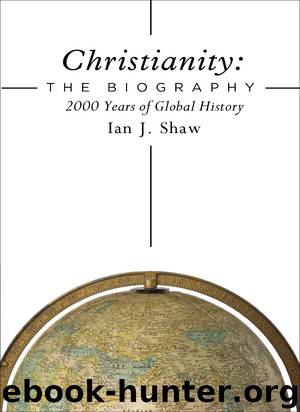Christianity by Ian J. Shaw

Author:Ian J. Shaw
Language: eng
Format: epub
Publisher: Zondervan
Published: 2016-12-01T05:00:00+00:00
China
Following the arrival of Alopen in the seventh century, Christianity was allowed to develop in China during the Tang dynasty (618–907). This foothold lasted for only two centuries, but it was restored by Roman Catholic missionaries during the Mongol or Yuan dynasty (1271–1368). Although the famous Genghis Khan (c. 1162–1227) married a niece of a Christian Kerait ruler, the Mongol threat to Europe was considered very great. Mongol invasions, such as that of Russia, sparked fear across Europe, but also deeper interest in mission to the Mongols, who ruled the largest empire in the world.
The first Franciscan missionary to the Mongols, John of Plano Carpini, arrived in 1245. He was followed by other Franciscans and Dominicans who sought permission to work among this much-feared people. They observed little official interest in their message, but they did discover Buddhist temples and mosques in the Mongol capital. They also found a small but well-established community in the East Syrian tradition. Roman Catholic missionaries rejected its Nestorian tendencies, as well as a syncretistic tendency to draw elements of Buddhism and even local cultural superstitions into their practice. They also felt that the morality of the East Syrian clergy was severely lacking. In turn, the East Syrians viewed the Catholic missionaries as schismatic.
The East Syrian Church had gained a measure of official acceptance in the Mongol empire, but its divisions and the lack of clarity of its message prevented it from taking full advantage of the opportunities available. Nonetheless, in the thirteenth century, the East Syrian patriarch exercised ecclesiastical power over a greater geographical area than the pope. East Syrian Christianity remained the dominant expression of Christianity in Asia well into the fourteenth and fifteenth centuries. A report from 1330 suggested there were 30,000 East Syrian Christians in China, with well-decorated churches and enjoying privileges from the emperor. Reports that East Syrian Christianity reached Korea, Japan, Thailand, the Philippines and Java between the thirteenth and fifteenth centuries are hard to verify, especially the further south and east the claims go, but there may have been East Syrian Christians on the Chinese–Korean border before 1000.
Kublai Khan, who in 1279 became the first Yuan emperor of China, had a Christian mother. His pragmatic policy of toleration of all religions allowed for a small Christian presence in China, which was offered some protections. Marco Polo (c. 1254–1324), who served as the only Western advisor in the court, felt that although Kublai Khan showed respect for Christianity, the ignorance and poor standards of the East Syrian clergy held back its advance. The missionary efforts of educated Buddhist monks were far more successful and eventually led to Buddhism being accepted as a Chinese religion, not a foreign one. However, the popes were more preoccupied with internal matters, and the last vestiges of the Crusades, than in major investment in mission to the Far East, and the opportunity passed. The death of Kublai Khan in 1294 signalled the end of the Mongolian Empire which had encompassed China, Central Asia, Persia and Russia, and thereafter the wind decisively turned against the churches in the East.
Download
This site does not store any files on its server. We only index and link to content provided by other sites. Please contact the content providers to delete copyright contents if any and email us, we'll remove relevant links or contents immediately.
The Gnostic Gospels by Pagels Elaine(2445)
Jesus by Paul Johnson(2278)
Devil, The by Almond Philip C(2249)
The Nativity by Geza Vermes(2153)
The Psychedelic Gospels: The Secret History of Hallucinogens in Christianity by Jerry B. Brown(2097)
Forensics by Val McDermid(2013)
Going Clear: Scientology, Hollywood, and the Prison of Belief by Lawrence Wright(1912)
Going Clear by Lawrence Wright(1897)
Barking to the Choir by Gregory Boyle(1750)
Old Testament History by John H. Sailhamer(1734)
Augustine: Conversions to Confessions by Robin Lane Fox(1716)
The Early Centuries - Byzantium 01 by John Julius Norwich(1676)
A History of the Franks by Gregory of Tours(1655)
A Prophet with Honor by William C. Martin(1648)
Dark Mysteries of the Vatican by H. Paul Jeffers(1645)
The Bible Doesn't Say That by Dr. Joel M. Hoffman(1626)
by Christianity & Islam(1580)
The First Crusade by Thomas Asbridge(1555)
The Amish by Steven M. Nolt(1509)
